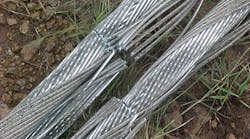Metal Theft in South Africa
The theft of underground copper cables and overhead conductors from installations owned by electric utilities, municipalities, telecommunications companies and various railway control systems in South Africa has resulted in disruptions to these public services and, ultimately, their customers. At the same time, the operators of these services have experienced a reduction in income and an increase in cost because of the necessary restoration.
The South Africa Chamber of Commerce and Industry (SACCI) estimated losses resulting from the theft of copper at US$1.15 million in October 2014. Copper theft amounted to 173 tons (191 U.S. tons) in September 2014 and 160 tons (176 U.S. tons) in August 2014. The cost of these losses was $1.74 billion, per SACCI. In addition, South African exports of waste copper products to countries including India and China amounted to $40 million in August 2014. Overall, it is estimated that copper thefts have a devastating effect on the South African economy, with indirect costs estimated at $440 million annually.
The international average monthly spot price of copper increased from $6824 per ton in June 2014 to $7116 per ton in July 2014. This is the first time the monthly average has breached the psychological $7000 price barrier since February 2014, creating an even more lucrative incentive for these thefts. This recent increase in price is the major driver for copper theft.
Impact to Utilities
Transnet, South Africa’s railway utility, has reported 6917 incidents of copper cable theft from 2008 to date. The thefts are valued at $8.34 million and resulted in a replacement cost of $20.87 million in addition to incurring train delays and cancelations.
In 2014, the Cape Town Chamber of Commerce reported 72,533 incidents of copper cable theft and made 10,736 arrests, resulting in replacement and repair costs of ZAR22 million.
Eskom, South Africa’s state-owned power utility, reported an estimated $32.14 million of copper cable had been stolen in 2010-2011, with an indirect cost to the economy of about $440 million. This included the cost of replacement and security; shutdown of business operations; loss of income; loss of exports; power, communication and transport outages; and negative investor perceptions.
Copper is not the only metal criminals target. Aluminium conductors installed on overhead transmission lines and sections of the supporting steel tower members also are being vandalized and sold to scrap metal dealers. The local authority electricity distributors in South Africa’s largest cities all are reporting theft of copper cables, steel sections from transmission towers and copper from customers’ homes.
Eskom also reports the theft of steel from transmission towers and theft of copper cables. Although copper and cable theft is common, the incidence of steel being stolen from towers is increasing. Eskom’s security team, working with the police, believes this latest example of metal theft is attributable to the dramatic increase in the price of steel. In 2011, Eskom’s transmission division suffered losses of $2.24 million (ZAR2.9 million) from conductor theft and $440 million from theft of steel tower members.
Preventing Theft
Work started on the prevention of theft from steel towers on a transmission line in 2008, when a tension tower on a 132-kV double-circuit transmission line interconnecting two major 132/11-kV substations collapsed as a result of vandalism. Bolts had been removed from the tower and structure members. The incident resulted in 100% system disturbance for about 0.08 seconds and a loss of 110 MW to 15 transmission voltage customers, including the main manufacturing plant of Toyota, SAB and the international airport. The estimated loss of revenue amounted to approximately $80,000. However, the loss was even greater for the industrial customers who had no supply for 48 hours.
eThekwini Municipality Electricity (EME), an electric utility in the municipality of Durban, KwaZulu-Natal, South Africa, is one of the largest distributors for Eskom. With 520,000 industrial, commercial and residential customers located in an area of 1600 sq km (618 sq miles), the utility has an overhead transmission line network of 145 km (90 miles) of 275-kV lines and 478 km (297 miles) of 132-kV lines, mainly double-circuit supported by steel towers. Like Eskom and other major South African utilities, EME continued to have its steel tower members stolen from 2009 through 2013. It grew to a level that steel replacement became a daily exercise for linemen, costing the utility approximately $125,000 per year.
An additional $167,000 was incurred for security patrols in high-risk areas. Fortunately, the theft of tower members was curtailed since the introduction of these patrols, but some towers with missing members were still at risk of collapse under moderate wind conditions.
Other South African utilities, including Eskom, have experienced collapsed towers because of theft, and in 2014, more than five incidents of tower collapse occurred in South Africa to various utilities, causing extended outages.
Combating the Problem
In response to the national problem of cable theft, the Non-Ferrous Crime Combating Committee (NFCCC) was formed and, in conjunction with provincial bodies, a strategy was developed for a sustainable reduction in cable theft. The NFCCC’s strategy seeks to address the cable theft problem by including stakeholders, such as the Department of Trade and Industry, the South African Revenue Services, Eskom, Telkom, Metrorail, Business Against Crime, the South African Police Service and the International Trade Administration Commission.
The level of SACCI’s copper theft barometer decreased from $1.3 million in May 2014 to $1 million in June 2014. It is too early to determine whether this decline is a temporary dip in the recent upward trend or possibly a positive indication of a downward trend. The preventive measures have been met with mixed success. In some cases, the thefts were linked to drug abuse, and members of the community were afraid to report it for fear of reprisal by drug gangs or out of a desire to protect friends or family members.
Marking Tower Sections
Two new anti-theft measures have been implemented to curb thefts from steel towers. One solution is to replace normal standard steel bolts with hydraulically installed swage bolts that can only be removed using a special hydraulic tool rather than a standard spanner.
Another solution currently under investigation is marking all steel tower members with the utility’s name using a battery-operated punching machine. Another approach is painting steel members at the base of the tower with bituminous paint mixed with tile cement, which creates low-value tacky-painted steel. The steel would be more difficult to cut with a hacksaw and hard to clean, thereby reducing the price the steel would yield.
Installing Alarm Systems
Several organizations, including EME, investigated alarm and surveillance systems. Following five years of intense research and development with various local utilities, an electronic theft monitoring solution was developed. In 2013, EME produced a full technical specification and invited all interested companies to bid on manufacturing, supplying and installing the specified system.
The contract, valued at approximately $292,000, was awarded to Phoenix Instruments, a South African company, to manufacture, supply and install the first 250 units. These units were used as a pilot to test the effectiveness of the system. Having been expanded to 278 units, the pilot was a success, and the installation of an additional 500 units is in progress.
Each electronic theft warning unit is powered by an onboard battery supported by a solar panel and installed on towers considered to be high risk. The unit detects vibration caused by any activity, such as the steel tower bolts being loosened or the tower steel being cut by a hacksaw or grinder. The unit also now detects an acetylene torch flame, even during daylight. An alarm is sent by global system for mobile (GSM) communications to security control personnel in the data monitoring center, who then dispatch security teams to investigate the incident. The system has software that uses image processing to detect any movement near the tower or mask areas in the image that could be responsible for false alarms.
In a surprising and unexpected spin-off, the system also detects the movement of birds near towers. It is now envisaged the system can be used to monitor bird collisions with power lines. The successful application of this feature will be reported in the near future.
Although still in the early stages, the system provides other significant benefits. The first benefit is security personnel only need to be deployed to locations where suspected activities on the structure have been detected and confirmed, instead of the costly continuous patrol used previously. The second benefit is a reduction in the number of theft incidents from an average of 30 incidents annually between 2009 and 2013 to only 13 incidents in 2014. The third and foremost benefit is the system has reduced the risk of a tower collapse, as now most incidents of steel tower theft are discovered early enough to allow for repairs, hence preventing the devastating consequence of a total collapse.
Initially a problem was identified. The units were installed about 6 m (20 ft) above ground level, which resulted in the units being visible to the public. Hence, incidents of the unit’s solar panel were reported stolen. To prevent solar panel thefts, the units are now installed in closer proximity to the live conductors at 15 m (49 ft) above ground level, and the first units installed were moved to the higher position.
In 2015, EME embarked on the procurement of a new theft monitoring system with an improved technical specification developed for the mass rollout of the theft monitoring system.
Making Progress Toward a Solution
The problem of theft of nonferrous metal and steel remains a problem in South Africa, augmented by social conditions, the desperation of people and the unscrupulous trade of these metals. The economic consequence for industry as well as civil society is daunting.
All electric utilities in South Africa have been hit by the theft of underground cables as well as steel sections from lattice transmission towers. The actions of these criminals have resulted in prolonged outages and structurally unstable towers that, in some cases, have led to a collapse, resulting in load losses. In addition, some cases of stolen live conductors have already resulted in deaths of the culprits.
The development of the electronic theft warning unit for transmission towers installed by EME has shown to date it is effective in deterring those participating in metal theft.
Hein Vosloo retired from Eskom in August, where he worked in the transmission group and was responsible for strategic management of transmission rights-of-way dealing with vegetation and animals. He is a registered land surveyor and has a master’s degree in geography on the life-cycle management of transmission rights-of-way. He worked on managing fire risks to transmission power lines and has been active in work groups of the CIGRE study committees since 2000. He is the task force leader of CIGRE Work Group B2-45, studying the effects of fires under power lines.
Duma Mhaule holds a BSEE degree from the University of KwaZulu-Natal and is a high-voltage overhead line engineer at eThekwini Municipality Electricity. With six years of experience, Mhaule is responsible for design, construction and maintenance as well as conducting major refurbishment projects. Mhaule is a registered professional engineer for the Engineering Council of South Africa and a member of the South African Institute of Electrical Engineers.





